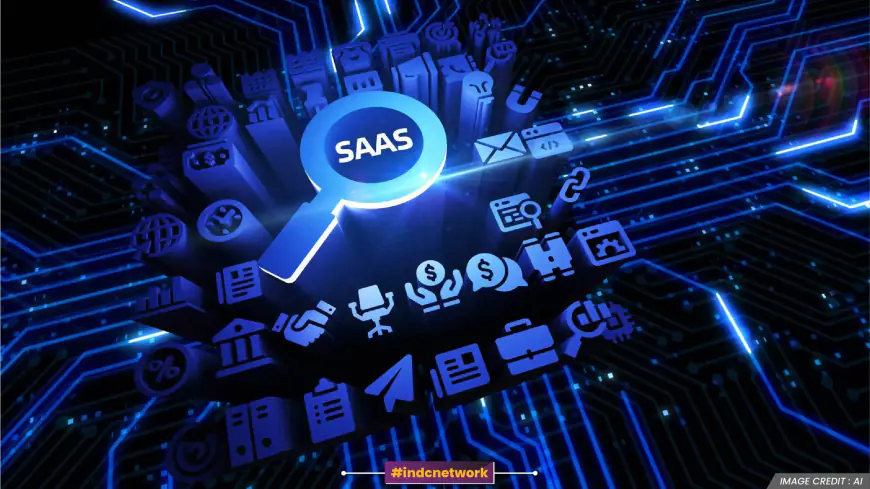The Future of Software as a Service (SaaS): Key Trends and Predictions Shaping the Next Decade
Software as a Service (SaaS) is evolving rapidly, with emerging trends and predictions shaping its future landscape. This article delves into the current trends in SaaS, such as the rise of artificial intelligence, the growing importance of cybersecurity, and the shift towards microservices architecture. It also explores the impact of user experience design, remote work, and subscription models on SaaS. By analyzing these trends and making predictions for the next decade, we provide insights into how SaaS will continue to transform businesses and enhance productivity in various industries.

INDC Network : Science : The Future of Software as a Service (SaaS): Key Trends and Predictions Shaping the Next Decade
Introduction : In recent years, Software as a Service (SaaS) has revolutionized the way businesses operate, providing flexible and scalable solutions that eliminate the need for traditional software installations. SaaS applications have become integral to various industries, offering tools for collaboration, project management, customer relationship management (CRM), and more. As technology continues to advance and user expectations evolve, the future of SaaS looks promising, with several key trends and predictions that will shape its development over the next decade.
This article explores the current trends influencing the SaaS landscape and makes predictions about its future direction. From the integration of artificial intelligence and machine learning to the increasing emphasis on cybersecurity and user experience, we will analyze how these factors will impact the SaaS ecosystem. Additionally, we will examine the implications of remote work, subscription-based models, and microservices architecture, providing insights into the future of SaaS and its role in enhancing business productivity.
Understanding Software as a Service (SaaS)
What is SaaS? : Software as a Service (SaaS) is a cloud computing model that allows users to access software applications over the internet on a subscription basis. Instead of purchasing and installing software on individual devices, users can access applications hosted on remote servers. This model offers several advantages, including lower upfront costs, automatic updates, and scalability, making it an attractive option for businesses of all sizes.
Key Characteristics of SaaS
- Cloud-Based Delivery: SaaS applications are hosted in the cloud, allowing users to access them from anywhere with an internet connection.
- Subscription-Based Pricing: Users typically pay a monthly or annual subscription fee, which can be more cost-effective than traditional licensing models.
- Automatic Updates: SaaS providers manage software updates and maintenance, ensuring that users always have access to the latest features and security patches.
- Scalability: SaaS solutions can easily scale to accommodate changing business needs, allowing organizations to add or remove users and features as needed.
Current Trends in SaaS
1. The Rise of Artificial Intelligence and Machine Learning : AI and machine learning are becoming increasingly integrated into SaaS applications, enabling organizations to leverage data-driven insights for better decision-making.
- Predictive Analytics: SaaS solutions are utilizing AI to analyze historical data and provide predictive insights. This helps businesses forecast trends, improve customer engagement, and enhance operational efficiency.
- Personalization: AI-driven SaaS applications can deliver personalized user experiences by analyzing user behavior and preferences. This enhances customer satisfaction and loyalty.
2. Growing Importance of Cybersecurity : As businesses increasingly rely on SaaS applications, cybersecurity concerns have come to the forefront. Protecting sensitive data from breaches and attacks is paramount.
- Enhanced Security Measures: SaaS providers are investing in advanced security features, such as encryption, multi-factor authentication, and real-time monitoring, to safeguard user data.
- Compliance and Regulations: SaaS providers must comply with various regulations, such as GDPR and HIPAA. Ensuring compliance is critical to maintaining user trust and avoiding legal repercussions.
3. User Experience Design (UX) : User experience design plays a crucial role in the success of SaaS applications. As competition intensifies, providing a seamless and intuitive user experience is essential.
- Intuitive Interfaces: SaaS applications are focusing on creating user-friendly interfaces that simplify navigation and enhance usability.
- User Feedback Loops: Many SaaS providers are implementing feedback mechanisms to gather user input and make iterative improvements to their applications.
4. Remote Work and Collaboration : The COVID-19 pandemic has accelerated the shift toward remote work, driving the demand for SaaS solutions that facilitate collaboration and communication.
- Collaboration Tools: SaaS applications that support remote collaboration, such as video conferencing and project management tools, are experiencing significant growth.
- Flexibility and Accessibility: Remote work has increased the need for flexible, cloud-based solutions that employees can access from various locations and devices.
5. Subscription-Based Models : The subscription model has become the standard for SaaS applications, providing businesses with predictable revenue streams and flexibility.
- Tiered Pricing: Many SaaS providers offer tiered pricing models, allowing customers to choose the features and capabilities that best suit their needs and budgets.
- Freemium Models: Freemium models enable users to access basic features for free, with the option to upgrade to premium features. This strategy helps attract new users and convert them into paying customers.
6. Microservices Architecture : The adoption of microservices architecture is transforming the way SaaS applications are developed and deployed.
- Agility and Scalability: Microservices allow developers to build applications as a collection of loosely coupled services, making it easier to scale and update specific components without impacting the entire system.
- Faster Time to Market: Microservices architecture enables faster development cycles, allowing SaaS providers to release new features and updates more quickly.
Predictions for the Future of SaaS
1. Increased Adoption of AI and Automation : As businesses seek to optimize operations and improve efficiency, the integration of AI and automation into SaaS applications will become more prevalent.
- Automated Workflows: AI-driven automation will streamline repetitive tasks, allowing users to focus on higher-value activities. This will enhance productivity and reduce operational costs.
- Intelligent Decision Support: SaaS applications will increasingly provide intelligent decision support tools that analyze data in real-time, offering actionable insights and recommendations.
2. Greater Focus on Security and Compliance : The growing reliance on SaaS applications will prompt a heightened focus on security and compliance.
- Proactive Security Measures: SaaS providers will adopt more proactive security measures, including advanced threat detection, incident response, and user education programs to mitigate risks.
- Regulatory Compliance: As data privacy regulations continue to evolve, SaaS providers will need to stay ahead of compliance requirements to maintain user trust and avoid penalties.
3. Continued Emphasis on User Experience : User experience will remain a top priority for SaaS providers as they seek to differentiate themselves in a competitive market.
- Personalized Experiences: SaaS applications will leverage AI to deliver highly personalized user experiences, tailoring content and features to individual preferences.
- Seamless Integrations: As businesses use multiple SaaS applications, seamless integrations between different platforms will become increasingly important, providing a unified user experience.
4. Expansion of Vertical SaaS : Vertical SaaS refers to industry-specific solutions designed to meet the unique needs of particular sectors. The demand for vertical SaaS will continue to grow.
- Specialized Solutions: Businesses will increasingly seek SaaS applications that cater to their specific industry requirements, such as healthcare, finance, or manufacturing.
- Enhanced Functionality: Vertical SaaS solutions will provide specialized features and functionalities that address the unique challenges faced by businesses in specific industries.
5. Evolution of Pricing Models : As the SaaS landscape matures, pricing models will continue to evolve.
- Consumption-Based Pricing: Many SaaS providers will adopt consumption-based pricing models, allowing customers to pay for only the features and usage they require.
- Flexible Subscriptions: Subscription models will become more flexible, enabling businesses to scale their usage up or down based on their changing needs.
6. Integration of Augmented and Virtual Reality (AR/VR) : The integration of AR and VR technologies into SaaS applications will open new possibilities for user engagement and collaboration.
- Immersive Experiences: SaaS applications in industries such as education, training, and design will leverage AR and VR to create immersive user experiences.
- Virtual Collaboration: AR and VR technologies will enhance remote collaboration by enabling virtual meetings and interactive environments for teams to work together.
Conclusion : The future of Software as a Service (SaaS) is poised for significant transformation, driven by emerging trends and technological advancements. As businesses increasingly rely on SaaS applications to enhance productivity and streamline operations, the integration of AI, enhanced security measures, user experience design, and the shift towards remote work will shape the SaaS landscape.
By staying ahead of these trends and making informed predictions, businesses can better prepare for the evolving SaaS environment and leverage the potential of cloud-based solutions to drive growth and innovation. As the SaaS ecosystem continues to mature, it will undoubtedly play a critical role in shaping the future of work and transforming how organizations operate across various industries.
What's Your Reaction?














































































































































































